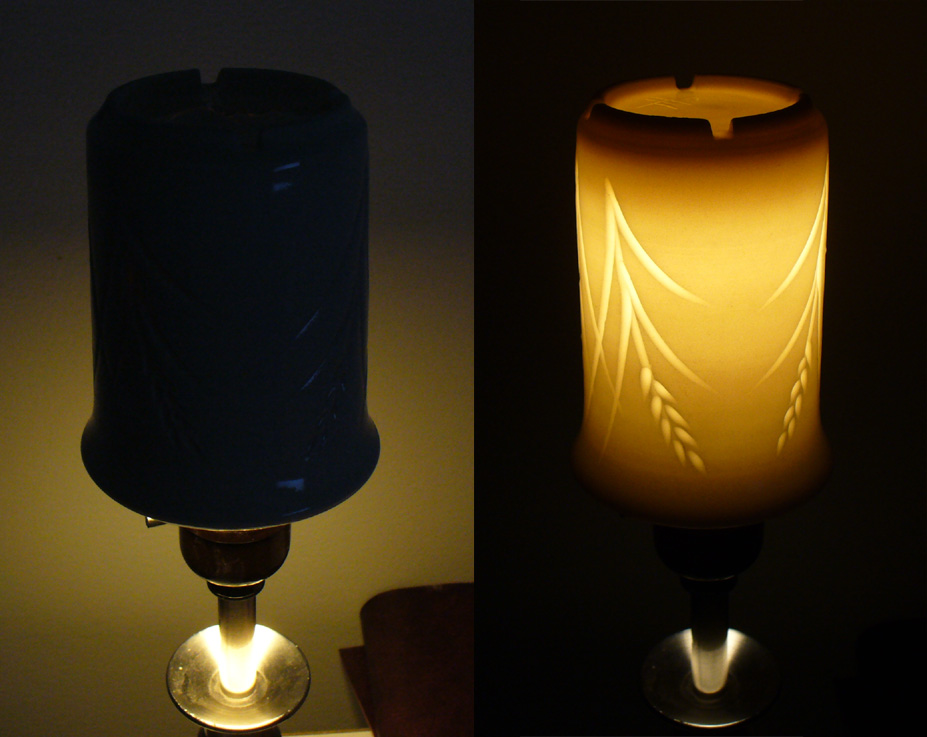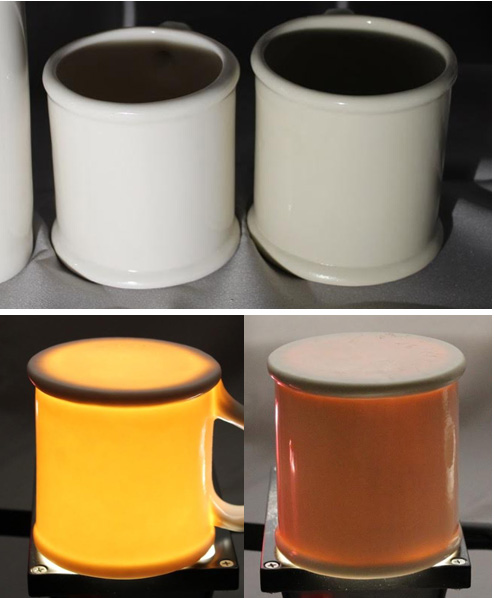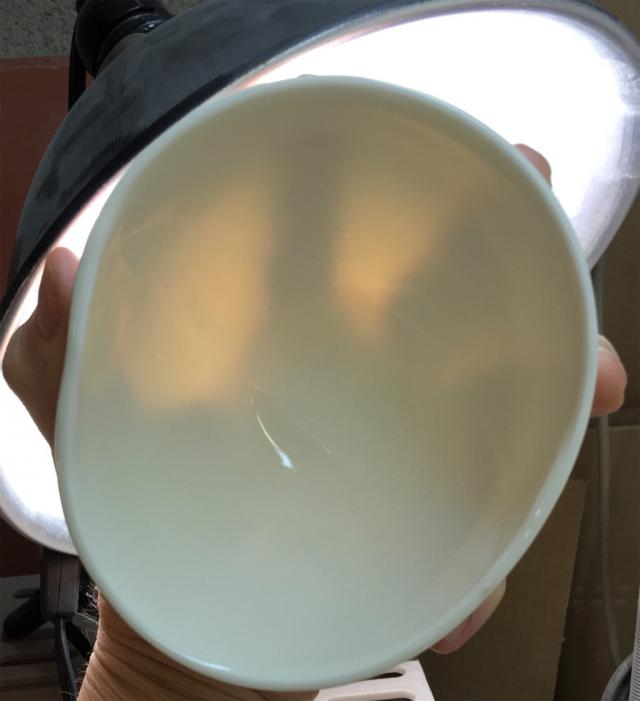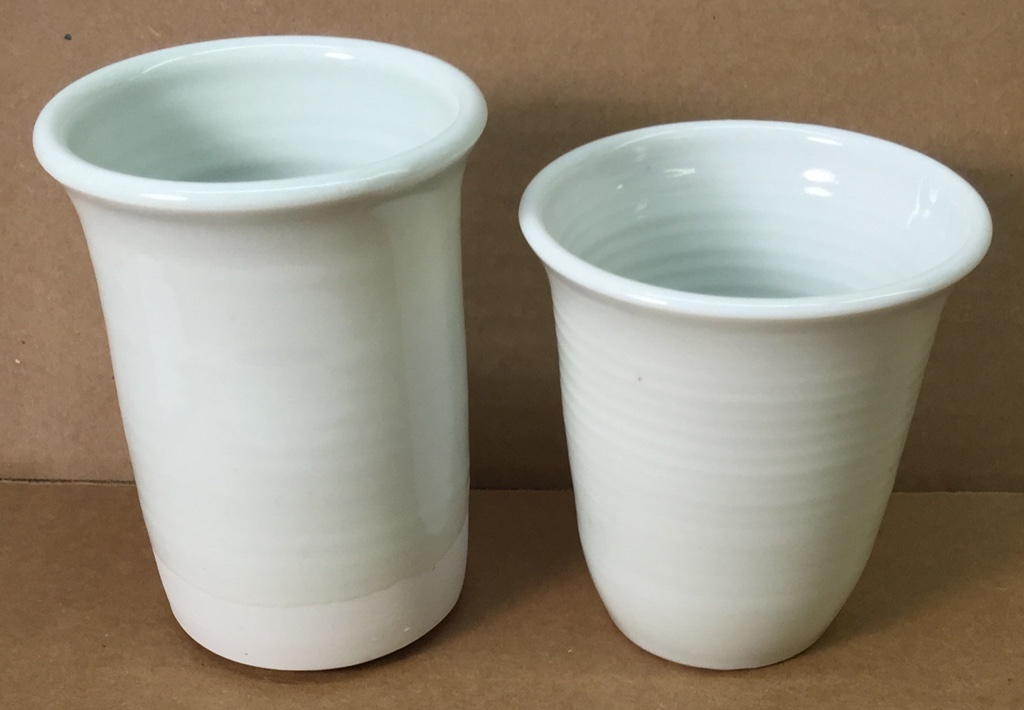| Monthly Tech-Tip | No tracking! No ads! | |
Translucency
A highly sought-after property in porcelain, fired close enough to melting to take on the glass-like property of passing light. Translucency implies tendency to warp during firing.
Key phrases linking here: translucency, translucent - Learn more
Details

Standard vs Translucent Porcelain
Translucent porcelain enables the passage of light through the wall of the item. Bone china is translucent. However, it is so vitreous that pieces cannot maintain their shape during firing. To resolve this problem bisque firing is done in holders and setters, and pieces are finished using glazes that melt at much lower temperatures. In recent years the availability of white-burning plasticizers has made it possible to maximize feldspar content in even potter's porcelains, resulting in very translucent ware without the need for bone ash or traditional cone 12 bone china temperatures.
Thus today, most companies find the traditional bone-china process to be unnecessary in producing a super-white translucent porcelain. But there are more factors at play to produce translucency in non-bone-china porcelain than it might at first appear. Of course, it is well known that kaolins containing significant titanium impede translucency. Thus, the most sought-after kaolins are those with low TiO2 and low iron content (Grolleg and New Zealand china clay are examples). It seems obvious that bodies need to be fired to a point well past where they reach zero porosity to have really good translucency. But this is not necessarily true. It also seems obvious that the range within which good translucency happens, and ware is stable enough to hold itself in shape during firing, would be very narrow. Again, this is not necessarily true. Using frits as a flux also seems obvious to achieving really good translucency, but this is not necessarily true either, feldspar-only porcelains can be very translucent. Also, as noted and contrary to what many people believe, high temperatures (cone 10 and beyond) are not required for good translucency.
The recipe for a cone 10 translucent plastic porcelain is really quite simple: It needs 20-25% silica for glaze fit. It needs 2-4% white bentonite (e.g. VeeGum, Bentone) for workability. 25% feldspar (high-quality low iron) will give less fired warping and less translucency, 35% will give the best translucency and the least stability in the kiln. The rest of the recipe is high-quality white-burning kaolin (e.g. New Zealand). For a casting version, cut the bentonite to 1% or less (just enough to impart the plastic strength needed to pull away from the mold). Some white kaolins (e.g. English) contain significant fluxes so less feldspar is needed (up to 10% less), this enables higher kaolin and/or silica percentages.
Cone 6 porcelains are more of a challenge because more feldspar is needed (leaving less room for kaolin in the recipe). Here is one secret of how to achieve translucency at cone 6: Veeum T. The L3778D recipe is an example of its use. Although not advertised by its manufacturer and not known by them, Veegum imparts translucency when used in larger amounts (up to 4%), so much less feldspar is needed (we have achieved excellent translucency with as little as 20%). Of course, it is very expensive, that 4% will cost more than the other 96% of the ingredients. The low-iron, low-titanium kaolins are not plastic, so they produce porcelain bodies of poor working properties. But the Veegum more than makes up for that, producing body workability that seems impossible for the whiteness and translucency achieved. We have not found frits to work nearly as well as Veegum.
For low temperature translucent porcelain frits are the only answer. Fritware bodies can mature as low at cone 02 (or even lower) if you can afford the frit. We have found Ferro Frit 3110 works well, our Zero3 porcelain is an example.
Of course, glazes and engobes can also be translucent, depending on the degree of melt and the presence of opacifiers, colorants and crystallization.
Related Information
The translucency of Polar Ice porcelain

This picture has its own page with more detail, click here to see it.
Polar Ice is made by Plainsman Clays, it is by far the most expensive body they make (because of the use of New Zealand kaolin and VeeGum). I call these my "sunshine mugs". They are fired at cone 6 (2200F) with a transparent glaze on the inside (G2926B) and G2934Y yellow silky matte on the outside (both mixed and applied at dipping glazes). This yellow glaze showcases the translucency in sunlight better than any other I have seen. The high plasticity and this "pie crust" method of making them enable thinner walls than any other method I know of, even casting. Although the walls of this piece are about 3.5 mm thick, I have achieved 2 mm using stiffer clay! Even with very thin walls, the weight of the handle does not pull the lips of these into an oval-shape.
A Lithophane exploits porcleain translucency to reveal its design

This picture has its own page with more detail, click here to see it.
Top: A thin porcelain tile with etched design. Bottom: The same tile with a back light. By Stephanie Osser. L3778G is an example of a translucent porcelain that will work for this.
Translucent Porcelain Lithophane by Stephanie Osser

This picture has its own page with more detail, click here to see it.
Made using porcelain fired to cone 11+. This is a splendid demonstration of translucency. Without a back-light it is just a white slab. But the varying thickness in the porcelain determine the amount of light that passes at any given spot, thus producing the design. An example of a recipe to produce a porcelain like this is L3778D.
Translucency of Polar Ice compared to another porcelain at cone 6

This picture has its own page with more detail, click here to see it.
On the top you can see the color difference. The other porcelain is made from a low TiO2 mix of typical North American kaolins, feldspars and bentonites. Bottom with a light inside: Polar ice on the left is far more translucent. Yet it is not overly mature, it resists fired warping remarkably well. And it is also more plastic (which seems impossible). There is a secret to the translucency that goes beyond the fact that it employs New Zealand kaolin and the percentage of feldspar it has. But I cannot tell you. But if you read this site carefully you will discover it in the most unlikely place!
Reduction Polar Ice vs. Oxidation Polar Ice

This picture has its own page with more detail, click here to see it.
Polar Ice (Plainsman Clays) has been fired to cone 10R (left). This is beyond the recommended cone 6 range, but it worked well in this instance. The result is even more translucency and a translucency of a different character: blue! This looks much more like real blue polar ice.
Polar Ice casting translucency

This picture has its own page with more detail, click here to see it.
A bowl cast from Polar Ice porcelain and fired to cone 6. I has a thinner wall than the thrown pieces made from Polar Ice throwing, yet it is much less translucent. This appears to be because the VeeGum is much less.
The secret of this cone 6 translucency will surprise you!

This picture has its own page with more detail, click here to see it.
Three cone 6 mugs. All have zero porosity. Why is the middle one so translucent? Three reasons.
1. It has 10% more feldspar than the one on the left and reaches zero porosity already at cone 5.
2. It employs New Zealand china clay while the one on the left contains high-TiO2 #6 Tile kaolin.
But this is also true for the one on the right. The third difference is the key.
3. The center one contains 4% Veegum T plasticizer (while the other two use standard bentonite). This is surprising when I tell you one more thing: The mug on the right also contains 3% Ferro Frit 3110. That means that the frit does not have near the fluxing power of the VeeGum!
Want to make a cone 10R super translucent porcelain? Think again.

This picture has its own page with more detail, click here to see it.
On the right is a porcelain used in China, renowned for its whiteness and translucency. On the left is a body made from Grolleg kaolin, this is commonly used by potters. They were fired in reduction. The tiny iron specks that potters do not even notice are enemy number for the blue-white porcelain like this. Although they might be small the reduction atmosphere makes them blossom out in full glory to ruin the piece. These specks come as contaminants in the materials (especially the silica) and they are easily picked up during fabrication. For very white bodies like this, it is incredibly difficult to prevent the specks. For a perfectly white flawless result, the entire factory must be dedicated to this one body; they use wet processing, magnets, filter pressing, stainless steel equipment and impeccable procedures.
Grolleg vs New Zealand - Which kaolin is better for translucency?

This picture has its own page with more detail, click here to see it.
The NZK body, Polar Ice, is on the left. The Grolleg one, L3778D, is on the right. They are not the same recipe, the feldspar content in the L3778D has been adjusted to match the degree of vitrification (Grolleg contains some feldspar). Clearly, the NZK has better translucency. And it fires whiter.
Links
| Glossary |
Porcelain
How do you make porcelain? There is a surprisingly simple logic to formulating them and to adjusting their working, drying, glazing and firing properties for different purposes. |
| Glossary |
Vitrification
A process that happens in a kiln, the heat and atmosphere mature and develop the clay body until it reaches a density sufficient to impart the level of strength and durability required for the intended purpose. Most often this state is reached near zero p |
| Glossary |
Bone China
A ceramic whose priorities are translucency, whiteness, fired strength and resistance to thermal shock failure. |
| Glossary |
Transparent Glazes
Every glossy ceramic glaze is actually a base transparent with added opacifiers and colorants. So understand how to make a good transparent, then build other glazes on it. |
| URLs |
https://en.wikipedia.org/wiki/Herend_Porcelain_Manufactory
Herend Translucent Porcelain |
| URLs |
https://insight-live.com/insight/share.php?z=tgsPMxNsAP
Four Cone 6 (1200C) Casting/Throwing Porcelain Recipes (Grolleg and #6 Tile) Four recipes that can be adjusted to work for casting or throwing/hand building (by adjusting the percentage of bentonite). The more you are willing to spend on the materials the more whiteness, translucency and plasticity you will achieve. |
| By Tony Hansen Follow me on        |  |
Got a Question?
Buy me a coffee and we can talk

https://digitalfire.com, All Rights Reserved
Privacy Policy
